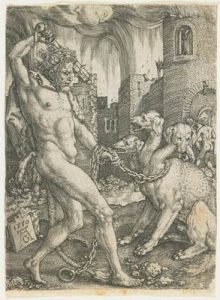(2016)
Cerberus, or the dog of Hades (as described by Homer), was the son of Typhaon and Echidna, a multi-headed devourer of flesh. According to scholar Maurice Bloomfield, diverse interpretations regarding the dog of Hades and his symbolism appear throughout history. However, it is only during the Second Century B.C. that Cerberus becomes associated with the terrifying being we know today – the three-headed dog, each head connected to a stage of life: childhood, youth, and old age – with the tail of a dragon and a back covered in serpent-heads. This is how Cerberus was portrayed by Apollodorus in his description of the twelfth labor of Hercules.
Among the many references to the dog of Hades, two are especially relevant to this composition. In his work Republic, Plato identifies Kerberos as the ideal representation of the soul, in which two or more contradictory natures grow concurrently until finally becoming unified. Inspired by this idea, my work continually manifests contradictory natures through a superimposition of multiple layers that develop concurrently at different speeds. The second source of inspiration is the Aeneid by Virgil. In book 6 of this epic, the terrifyingly ferocious dog-keeper of hell’s doors is conquered by Sibyl who “threw down a loaf with honeyed herbs.” Here the rapid “Furioso” passages are interspersed with more lyrical and contemplative “Tranquillo” sections, suggesting the taming of Cerberus.
